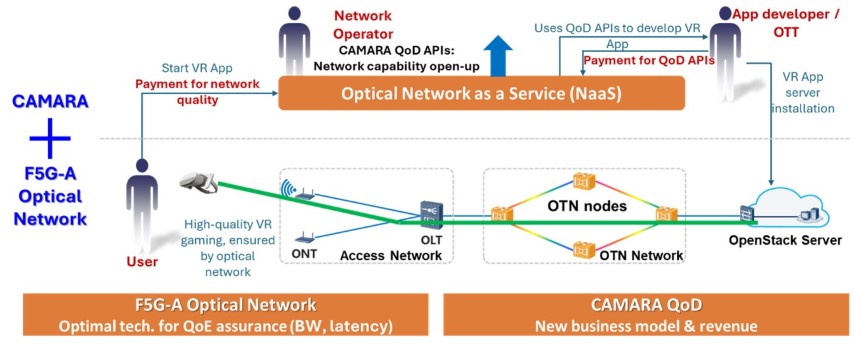Revolutionary F5G-based VR Gaming Service at Mobile World Congress 2024
At the Mobile World Congress 2024, the Centre Tecnològic de Telecomunicacions de Catalunya (CTTC) and Huawei Technologies introduced a groundbreaking Proof of Concept (PoC) that underscores the capabilities of the ETSI Industrial Specification Group (ISG) Fifth Generation Fixed Network (F5G). This demonstration exemplified a significant leap in Fixed 5G technology, using a Virtual Reality (VR) Gaming Service for Remote Players as a practical application of the F5G Advanced (F5G-A) architecture. The F5G-A architecture exploits the optical network capacities to provide high quality transmission with ultra-low end-to-end latency, high bandwidth guarantees, and minimized jitter to ensure the Quality of Experience (QoE) for cloud-based services. This architecture promises to reshape a myriad of high-demand digital services, offering unparalleled connectivity and intelligent End-to-End (E2E) service management.

A critical aspect of this PoC is the integration of the CAMARA project endpoints, especially those focused on serving Quality on Demand (QoD) connectivity services, which offers a unified approach to telco network and cloud infrastructure management. This holistic oversight is crucial for the flawless operation of end-to-end quality on demand services deployed on the F5G-A architecture, ensuring seamless cooperation among all network components. The demonstration employed a testbed illustrating the architecture's capability to support demanding quality-on-demand applications like VR gaming. This included an intricate setup of the F5G-A infrastructure composed of Optical Network Terminal (ONT) equipment, Optical Line Terminal (OLT), Optical Transport Network (OTN), Edge Provider Equipment (PE), OTN Switches, and Aggregation Edge equipment, culminating in access to Virtual Machine Gaming Servers through an OpenStack cloud resource manager.
Lluis Gifre (CTTC) and Hesam Rahimi (Huawei Canada) presented the demonstration focusing on the transformative potential of the ETSI F5G-A architecture and its applicability across various sectors. They showcased how key technologies like the ETSI TeraFlowSDN (TFS) and ETSI OpenSourceMANO (OSM) are pivotal in enabling such innovative services. The ETSI TeraFlowSDN (TFS), a cloud-native Software-Defined Network (SDN) controller, stands out for its comprehensive F5G-A network management capabilities. It is designed to handle the extensive data connectivity requirements of services like VR gaming, ensuring smooth and uninterrupted experiences. Meanwhile, the ETSI OpenSourceMANO (OSM) Network Function Virtualization (NFV) orchestrator optimizes the management of cloud computing resources, employing OpenStack APIs to configure a scalable and flexible infrastructure.
The architecture presented operates on a hierarchical model using standardized data models and interfaces. At its core, service requests, such as those from a Cloud VR Game Developer, are managed by the CAMARA Application Manager. This entity oversees the application and its connectivity, providing users with continuous access to services. The underlying infrastructure, managed by ETSI OSM, facilitates cloud computing resources and orchestrates connectivity between endpoints, such as user equipment and central servers. The ETSI TeraFlowSDN controller plays a vital role in managing data flow across the network, supported by Huawei’s NCE-T intermediate SDN controller, which utilizes IETF-based Northbound Interfaces (NBIs).
This PoC at the Mobile World Congress 2024 not only highlighted a technological milestone but also set the stage for the future of end-to-end quality-enabled telecommunications. By leveraging the latest ETSI standards and technologies, this collaboration exemplifies how the F5G-A architecture can support not just immersive and realistic VR gaming services but also a wide array of other digital services.

Institutional picture with ETSI Director General and CxOs, ETSI ISG F5G leaders
and key contributors from Huawei Technologies and CTTC

Showcase of VR gaming PoC demo to MWC’24 attendees

Group picture with key contributors to the PoC demo from CTTC and Huawei Technologies

Showcasing the VR gaming PoC demo to students from University of Seoul

